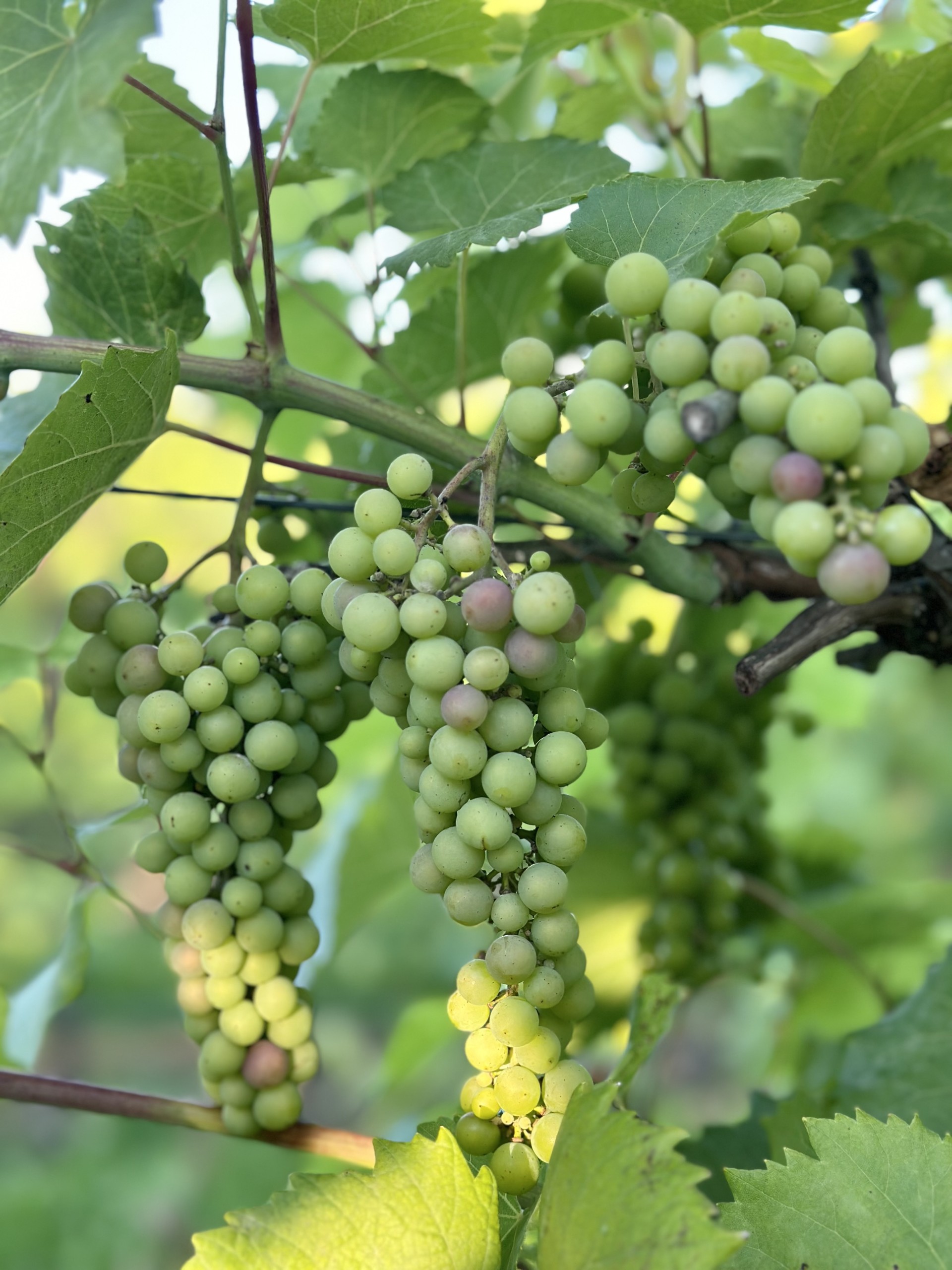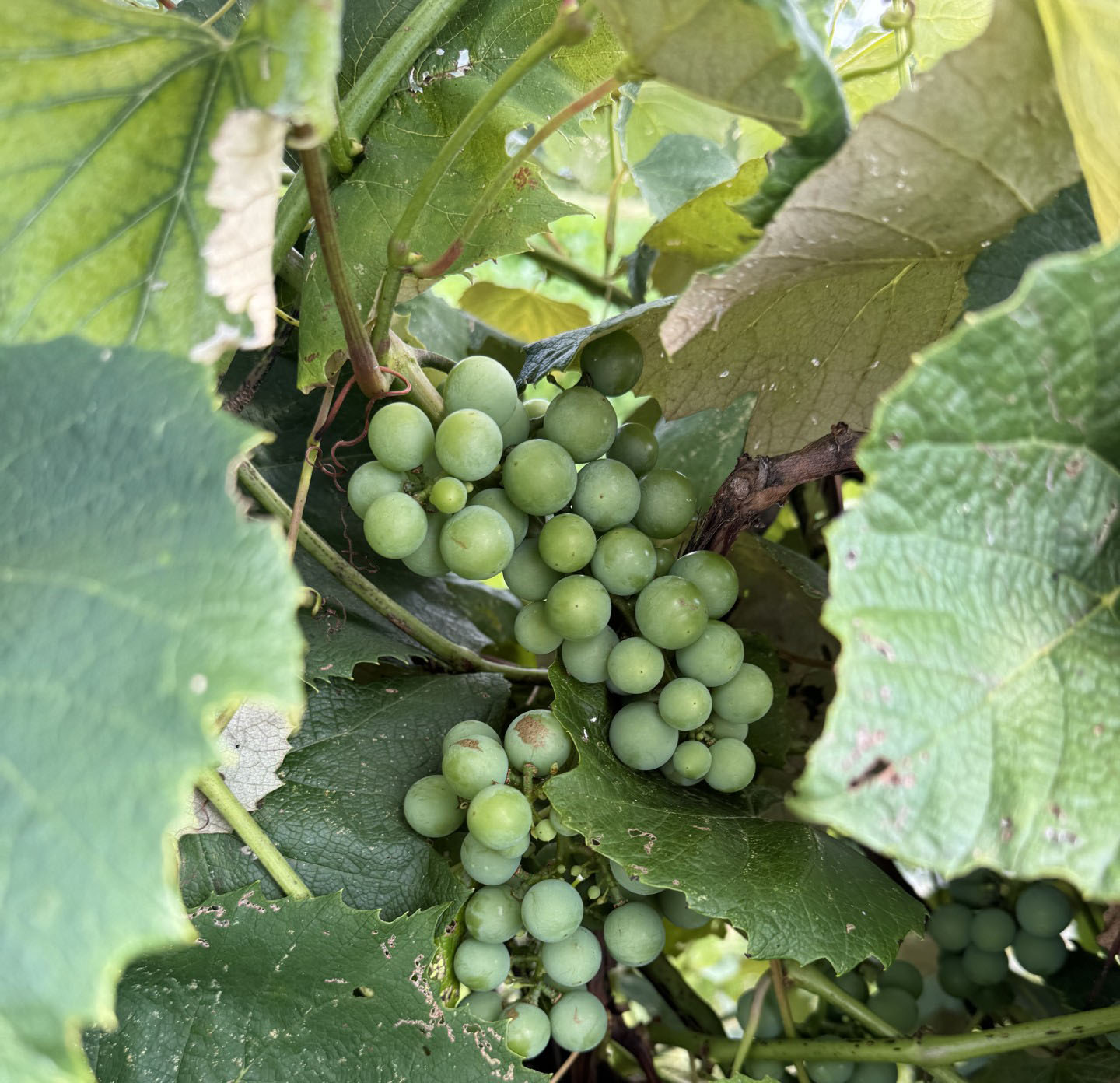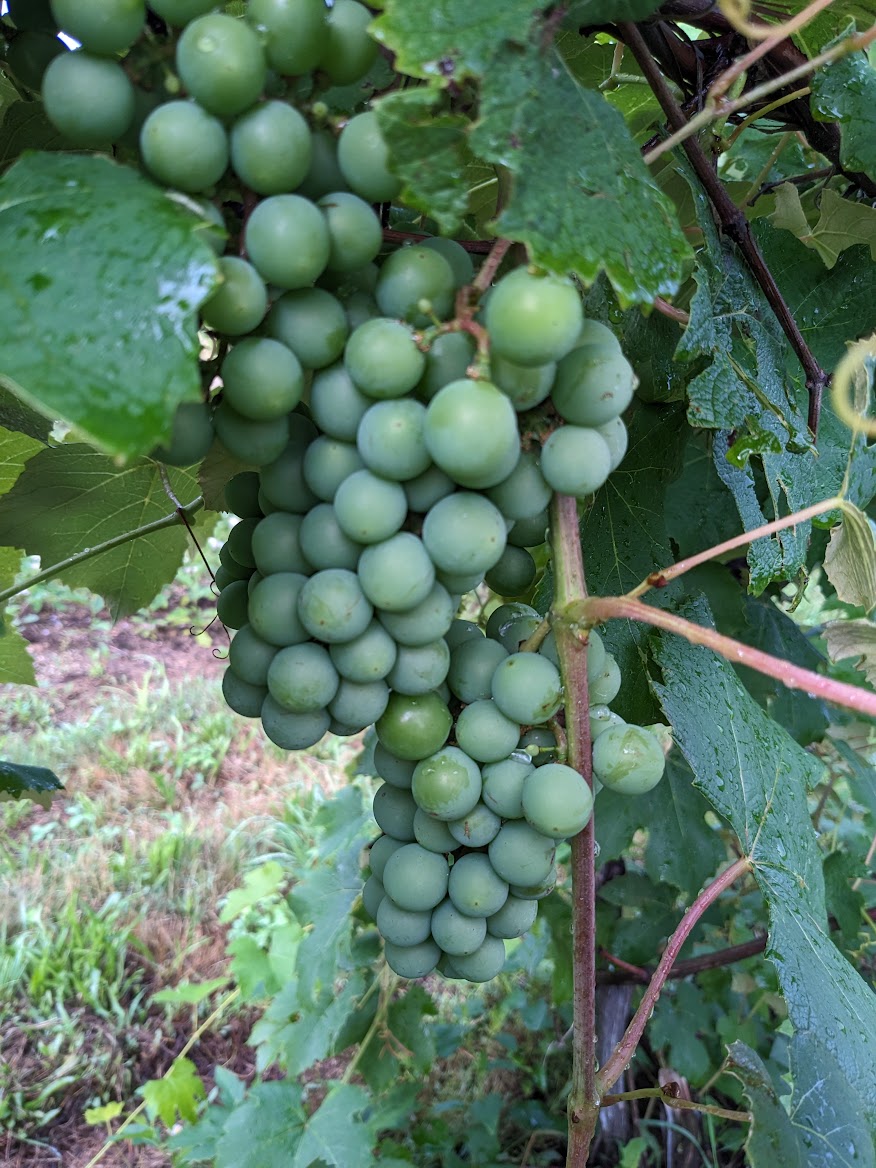Michigan grape scouting report – July 25, 2024
Stay informed and ahead of the curve with the latest vineyard updates and best practices in our comprehensive report. Enhance your grape growing success by leveraging expert insights on vine growth, disease management, and innovative tools.

Weather
Click the following links for detailed seven-day forecasts for various grape production regions.
Southwest
Southeast
Northwest
See the latest agricultural weather outlook from Jeff Andresen, Michigan State University state climatologist.
Check out the Michigan State University Enviroweather Growing Degree Days (GDD) Michigan map. Find your closest weather station, create an account on the website, and track GDDs daily.
Report on Growing Degree Days (GDD)
The following table summarizes the GDD base 50 degrees Fahrenheit for the current week and the previous week, as well as the accumulated GDD for each location.
|
Michigan grape growing region |
Current GDD 50 F |
GDD 50 F last week |
Collected the past week |
|---|---|---|---|
|
Benton Harbor (SWMREC) |
1782 |
1660 |
122 |
|
Fennville |
1586 |
1469 |
117 |
|
Lawton |
1761 |
1640 |
121 |
|
Average for southwest Michigan |
1709 |
1590 |
120 |
|
Romeo |
1640 |
1480 |
160 |
|
Average for southeast Michigan |
1640 |
1480 |
160 |
|
Old Mission |
1212 |
1101 |
111 |
|
Petoskey |
1198 |
1091 |
108 |
|
Traverse City (NWMHRS) |
1314 |
1191 |
123 |
|
Average for northwest Michigan |
1538 |
1411 |
127 |
Vine growth
Southwest Michigan
Veraison is officially underway in hybrid wine grapes. Marquette began late last week in some locations. Other varieties are at bunch closure. Black rot infections on clusters are extensive this year in some locations. Powdery mildew is still a challenge in some locations as well.
Southeast Michigan
Veraison has been observed in ‘Marquette’ in Macomb and Ingham counties. Concord and table grapes are at the lag phase of development.


RimPro models indicate there is a risk of powdery mildew infection from July 28-30 in the region, downy mildew infection risk peaking the 25 and 30-31, and potential black rot conidi infection on July 25 and 30-31.
Northern Michigan
Vinifera grapes are progressing well, with berries reaching the pea-sized stage. (E-L number 31 -32) and clusters are expanding. Shoots have grown above the last set of catch wires, and canopy management practices (e.g., canopy topping and hedging) will be needed in the next few weeks.
Tip of the Mitt region
The Tip of the Mitt region remains in a steady state of development. Berries on early hybrid cultivars are beginning to soften but veraison has not been noted. Canopy management continues. Black rot, Phomopsis and downy mildew pressure remains high.

Horticulture
Vineyard hedging is set to commence soon in Michigan, aiming to achieve several key objectives. The primary focus is on curtailing excessive primary and lateral shoot growth on the canopy's top and sides to prevent shading and entanglement between vine rows. By doing so, the vineyard becomes more accessible for workers and tractors. Interestingly, hedging also stimulates growth by promoting lateral shoot development in vigorous vines, despite the reduction of the canopy due to the removal of primary and lateral shoots.
It is recommended to perform hedging during the early to mid-summer period. Ideally, hedging is carried out between fruit set and veraison. This timing is crucial as it ensures adequate exposure of leaves, fruit and developing buds to sufficient light, especially in dense canopies of hybrid cultivars with excessive vegetative growth. To avoid potential issues, it is essential to refrain from hedging too early in the growing season, as it may lead to increased lateral growth and canopy density.
However, we consistently perform early-season hedging due to late bud break and elevated spring temperatures, which promote vigorous growth early in the season. We always avoid hedging during bloom or shortly thereafter to prevent increased cluster fruit set that consequently increases cluster compactness, making the clusters more prone to harvest season cluster rot complex diseases. Growing grapes in Michigan can be likened to a "100-meter sprint," as Craig Cunningham, an experienced vineyard manager in Michigan, describes it, compared to the marathon-like growing season of other viticultural regions. Typically, we hedge twice: once before veraison, and once after. Hedging three times in a season is unusual and indicates a problem. If your vines require a third hedging, it likely points to issues such as inappropriate rootstock selection, excessive nitrogen levels, or incorrect planting density.
Additionally, some juice grape vineyards have reported instances of over-cropping. Effective crop load management plays a pivotal role in achieving the desired sugar accumulation level at harvest in the fruit. An excellent tool to assess crop load is the Michigan State University (MSU) Concord model on Enviroweather, and conducting cluster thinning at 1,200 GDD is recommended.
Diseases
During this time of year, the primary diseases of concern for grape growers are phomopsis, black rot, anthracnose and powdery mildew. If you're seeking detailed insights into pre-bloom fungicide options and the effects of rain on disease spread, we recommend referring to a grape scouting report from earlier or exploring an article on early-season disease management. It's worth noting that some growers have recently observed isolated cases of downy mildew infections in northern vineyards. Southern vineyards have been seeing early infections of Phomopsis and are beginning to see black rot lesions on fruit and leaves. Powdery mildew symptoms are becoming more apparent, so vineyards should be scouted to check on the status of diseases.
With the exception of powdery mildew, these spring disease infections typically require rain events. It only takes 0.1 inches of rain above 50 F to trigger a possible infection. Viticultural practices that reduce canopy wetness such as good irrigation timing, leaf removal and good weed management can reduce many of these diseases in a vineyard. Typically, DMIs (FRAC 3), captan and EBDCs (FRAC M3) are effective for Phomopsis, black rot and anthracnose.
Remember, as you choose a fungicide, check the Michigan Fruit Management Guide for potential phytotoxicity of certain sprays on Concord grapes especially (this has been particularly noted for fungicides like Revus Top). Phytotoxicity risk is higher with high temperatures and quickly growing vines. Also, there is a significant phytotoxicity risk with specific contact products such as copper and sulfur for Labrusca type grapes (Concord and Niagara).
It is important to remember to manage fungicide resistance and avoid applying similar products back-to-back. This is particularly important with site-specific systemic fungicides. To reduce the development of resistance with systemic fungicides:
- Do not make more than two applications per season of the same FRAC code.
- Do not make two consecutive applications of the same FRAC code.
- Rotate with unrelated fungicides in a different FRAC code that have efficacy on the target pathogen.
- Include a contact multisite fungicide into a program (e.g., sulfur, captan, oils or biological fungicides).
Insects
The third generation of grape berry moth is predicted to start at the end of July and early August, depending on where your vineyard is located in the state. The table below shows the current predictions based on the grape berry moth model on MSU Enviroweather that calculates degree-days for your nearest weather station accumulated since the date of wild grape bloom back in the spring. The table below shows the situation for July 24, 2024. At this point, we can see the predicted date when Generation 3 egg laying will start in the far southwest of the state is in the last days of July. Areas with later wild grape bloom (you did record it, right?) or with cooler weather this summer will get to this stage some days later. These timings are the right time to apply Intrepid (watch the 30-day preharvest interval) or other egg-active insecticides where early application is essential for efficacy. For insecticides targeting egg hatch and aiming to kill young larvae before they enter the berries, the timing should be 100 degree-days later. If temperatures remain in the mid-80s, it would take another about five days to reach that target date. Generation 3 can be more intense than earlier in the season due to the higher population of grape berry moth, so this treatment at the start of the generation should be followed by another 10-14 days later to continue protection of the clusters toward harvest.
With many vineyards having low yield potential from frost damage, this coming week is a great time to look under the canopy at your clusters to see where there is some grape berry moth pressure building and where the vines are uninfested. Targeting border sprays only to reduce costs is one approach to consider if the sampling indicates pressure is only on the edge. Typically, the first about 10 rows get the most pressure from grape berry moth and it tails off after that as you get into the vineyard. Scouting can inform this approach.
|
Weather station |
Nearby wild grape bloom date |
Current grape berry moth degree days |
Start of Gen 3 egg laying (1620 GDD) |
Predicted start of egg hatch (1720 GDD) |
|---|---|---|---|---|
|
Berrien Springs, Berrien County |
19-May |
1473 |
30-Jul |
Early August |
|
Lawton, Van Buren County |
20-May |
1470 |
31-Jul |
Early August |
|
Fennville, Allegan County |
22-May |
1342 |
After July 30 |
Mid-August |
|
Grand Traverse, County |
3-Jun |
1314 |
First week of August |
Mid-to-late August |
As we mentioned last week, a second site in Michigan has been found with live spotted lanternfly in southern Monroe County just north of Toledo, Ohio. This site is not near any fruit agriculture. MSU is working with state and federal agencies monitoring sites across the state, including multiple vineyard locations. Growers can help out by reporting any suspect detections to the Department of Natural Resource’s Eyes In The Field.
Become a legacy user of the SAM Tool and enhance your vineyard management!
The Sustainable Agricultural Management (SAM) Tool is a comprehensive software application designed to streamline your vineyard management processes. We understand that adopting new technology can be daunting, but we believe the SAM Tool has the potential to transform your vineyard management for the better. This growing season, we are dedicated to offering personalized support. Thanks to the valuable feedback we've received, we continue to shape both the current features and the future of the tool.
The SAM Tool can manage tasks for a small number of individual vines, as well as large vineyards spanning hundreds and thousands of acres. Your participation as a legacy user will not only help us improve the tool but also provide you with a unique opportunity to be part of an innovative community. Together, we want to ensure it meets your needs and the needs of other Michigan vineyards.
Ready to get started? Let us help you migrate your spray plan to the SAM Tool and explore the many cool features we've created for you. The SAM Tool can automatically populate this year’s spray tasks into next year’s calendar, allowing you to edit each task to meet the following year’s needs.
Contact Karen Chou for personalized help migrating your spray plan to the SAM Tool and to help us fine-tune the tool so that it truly meets the needs of growers like yourself. We welcome the opportunity to serve vineyards of all sizes.
Upcoming events
The 35th annual Michigan Viticulture Field Day and inaugural Michigan Enology Experience are approaching. MSU’s famous field day and steak dinner is back on July 31. We are now adding a second day just for the winemakers.
Dirt to Glass™ 2024: Elevating Michigan Wine from the Ground Up, Aug. 22-23. Dirt to Glass aims to connect growers and producers each year and provides information to support the Michigan grape and wine industry in understanding the critical relationship between better farming and world class wine.
As a collaboration between Michigan State University, Michigan State University Extension and industry innovators and educators, this groundbreaking event disseminates the most current research and cutting-edge practical information to elevate the grape and wine industry.
This year's conference will continue the journey started in 2022, aiming to elevate the Michigan grape and wine industry through a deeper understanding of soil health and fertility, carbon cycle and sequestration, and soil-vine interaction, all crucial sustainability elements in producing high-quality grapes and wines from vineyard to economic sustainability. Each technical session will be complemented by wine educational sessions.
The Great Lakes Expo: Dive deeper into grapes this year. The Great Lakes Expo, held annually in early December at the DeVos Place Convention Center in Grand Rapids, Michigan, is the largest show of its kind in the country. It attracts a diverse audience of grape growers from the Great Lakes region.
This year's Grape Section takes place on Tuesday, Dec. 10, 2024. We're offering the Grape Section in two sessions to provide a more in-depth exploration of both juice and wine grapes:
Morning Session: Focuses on all things juice grapes, covering topics like varieties, cultivation practices and juice production.
Afternoon Session: Delves into the world of wine grapes, exploring varietals and viticulture techniques.
This expanded format allows you to tailor your experience to your specific interests, whether you're a juice grape grower, a wine grape producer or simply curious about both. Don't miss this valuable opportunity to connect with industry experts, gain valuable knowledge and explore the latest advancements in the grape growing industry.
We look forward to seeing you there!
To get a better sense of the Great Lakes Fruit, Vegetable, and Farm Market Expo, check out this video.
Related articles
- Early season vineyard management
- Early season control of grape berry moth in Michigan vineyards for 2022
- Rose chafer management for northwest vineyards
- Fruit insecticide registration update for 2023
- Southwest Michigan fruit update – June 4, 2024
- Michigan grape scouting report - June 15, 2022
- 2022 MSU Fruit Pest Management Guide (E-154)
- Grape growth stages
- Early season vineyard disease management
- Early season vineyard management
- A Mobile Guide for Grape IPM Scouting in North Central and Eastern U.S.
- Using the MSU Enviroweather grape berry moth model in 2018



 Print
Print Email
Email